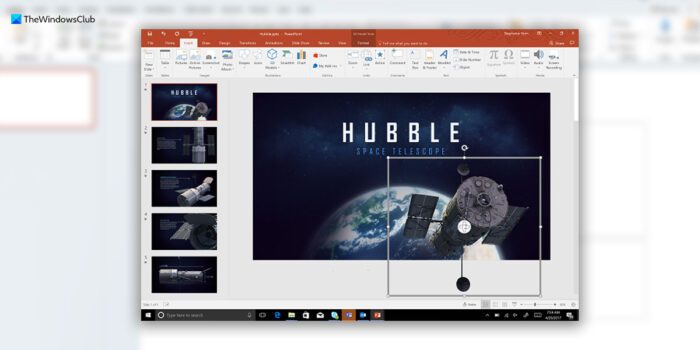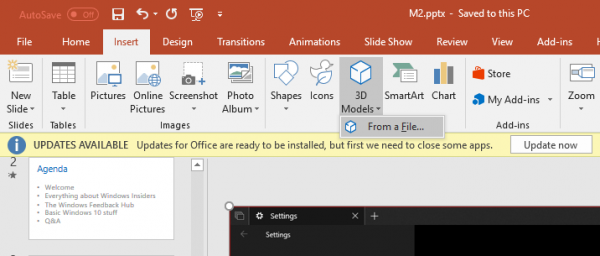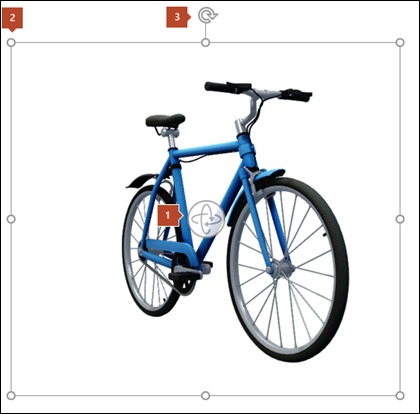Microsoft announced a new feature for Microsoft Office. Along with this, they focused more on 3D content coming to life with Surface Studio and Paint 3D. This was the ability to insert and animate 3D models to your PowerPoint presentation. As Microsoft employees demoed this feature, we looked at how better presentations can be delivered using these 3D models.

Microsoft showed off an example of a 3D model of the Hubble Telescope inserted into a presentation about the same. For your convenience, you can insert a .fbx file which contains the 3D object or get one from the Remix 3D collection from Microsoft. With the introduction of Paint 3D, Microsoft has allowed everyone running Windows 10 to create 3D models. Then, the .fbx file is saved for the project and can be uploaded to the open Remix 3D community where everyone can make use of the 3D creations from each other and use them at their ease.
Now, with this, Microsoft is also letting you insert the 3D Objects from third parties. With a number of third party websites providing 3D content for different purposes, you can leverage their use in building a gorgeous PowerPoint presentation too. Now, let us check out how to insert these 3D models in a PowerPoint presentation and animate them in an attractive manner.
Insert animated 3D Models into PowerPoint

First of all, in the Menu ribbon, click on Insert. You will find a section labeled as Illustrations where you see a button named as 3D Models.
There, you will be able to see options in the drop-down menu namely – From a file and From an online source.
The first option (From a file) will allow you to browse for 3D .fbx files stored locally on your computer.
The second option (From an online source) will let you browse the Remix 3D community and select a suitable object.

Once you get your 3D object inserted, you will see a number of buttons to play with it. You can rotate the 3D model as per your ease. If you wish, you can scale it vertically, horizontally and diagonally as well. Or you can just Zoom in and out to the 3D model. Once done, you are good to proceed further.
Changing how 3D Models looks in PowerPoint
So, after you select your inserted 3D model, click on the Menu named Format in the Menu Ribbon. There you can find a section called 3D Model Views where you can select the perfect view of your 3D Model out of some predefined views. You can see an example in the figure below.
 Animate 3D Models in PowerPoint
Animate 3D Models in PowerPoint
What is the fun of 3D Models when they do not move? Microsoft announced several new animations for 3D Objects. One of them is called Morph. With this animation, the user can zoom to different parts of the 3D Object and hence, gently defining them separately in different slides. This really gives a professional touch to one’s presentation.
![]()
There are other animations that give more realistic looks to these 3D objects. They are named as Arrive, Turntable, Swing, Rotate and Jump and Exit. You have options to customize how these animations work. You can set if you want these animations to take place continuously, work in reverse order, have halted and many more.
Microsoft has a demo video, displayed above, to show whatever we just talked about.
How do you add animation and 3D models in Microsoft PowerPoint?
To add or insert animation or 3D models in Microsoft PowerPoint, you can go through the aforementioned steps. The best thing is that you can insert the 3D model using the in-built option provided to you in the PowerPoint app. For that, switch to the Insert tab, and opt for the 3D Models option. Next, click on the From a File option and choose the model as per your requirements.
How do you insert a 3D model in PowerPoint?
To insert a 3D model in PowerPoint, follow the above-mentioned steps. As PowerPoint comes with an in-built option, you do not need to use a third-party add-in or service or anything else. You can go to the Insert tab, click on the 3D Models option, and choose the From a File menu. Next, you can select the file that you want to insert.
And as traditionally, we have worked with PowerPoint presentations, we can always check and set when these actions take place. Whether on a click, after the previous animations or with the next animation. That is a really high level of customizability that Microsoft is offering its customers.
Leave a Reply